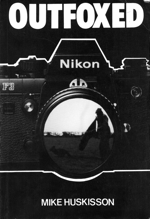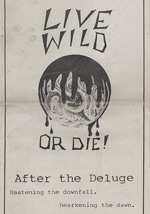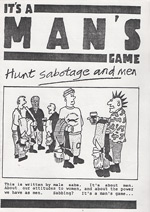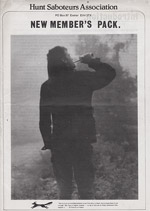» Next Entries
The Archives
-
Periodicals
The Animal Liberation Front Supporters Group Newsletter #17
07.17.11 | PermalinkThe Animal Liberation Front Supporters Group Newsletter #17 (1985, London, England.)
(Editors note: The complete set of SG newsletters is now available HERE.)
It is not usually our habit to put up a single issue of a serialized publication as we prefer to post an entire year, or run of magazines, in a single post. However, we must make an exception for the ALF SG Newsletter #17, which contains a fantastic investigation of the Band of Mercy and comes complete with an image of their first press statement from November of 1973. The significance of that image, the very first communique from an underground group fighting on behalf of other species, can not be understated.
When one considers how entrenched animal exploitation is in our culture, the idea that a tiny band of revolutionaries could push back against that social tide by burning down an animal laboratory under construction is a watershed moment. The arson attacks and raids carried out by the Band of Mercy were pivotal in the creation of the animal rights movement.
This issue has much more in store for readers. The second communique from the Animal Rights Militia is presented in it’s entirety, and although it provides a myopic examination of the role of liberatory violence it is none the less a fascinating read for lovers of animal rights history. The story of the famous Ecclesfield Beagle raid is presented by one of it’s participants, Roger Yates has a long letter explaining his feelings on the uselessness of national groups, and funny pseudonyms abound! If you thought Earth First!ers had funny names, wait till you get a load of Captain Kirk, Martial Rose, and Black Vixen!
If you look carefully you may notice that this issue is missing some pages. We do not know if this is because they were removed by their original owner, or if this is one of the issues of the SG rumored to have been “edited” by the British government as it left post offices on it’s way to subscribers.

…
-
Do or Die, Periodicals
Do or Die #5
07.02.11 | PermalinkDo Or Die #5 (1995, Brighton, England)
The story of Earth First! in the United States is well documented and frequently repeated, and someday it will certainly make it’s way to digital distribution here on Conflict Gypsy. (Scanning those hundreds of copies of EF! Journal is going to put our volunteers into early graves if we are not careful, so don’t expect to see a full set anytime soon!) Until that time it is our pleasure to delve into the history of Earth First! elsewhere in the world, starting in England and the other places still under colonial rule known as the “United Kingdom.”
Beginning in 1991 there was an explosion in activism across the pond. Wilderness, urban environmental, anti-road, alternative transportation, animal liberation, anarchist, squatters rights, and other specialized, single issue activist realms began to coalesce into an exciting new mass. The origins of this widespread movement had broad roots. Some trace its beginnings to the poll tax riots, others say it was government crack downs on raves, squats, and social centers. Where ever it came from, it grew within a few short years into a spectacular and inspiring mess for the status quo!
From encampments protecting wild areas, to sabotage, to street protests that took over whole city centers, the UK suddenly seemed alive with resistance. While never reaching a size that threatened the powers that be, these outbursts of love and aggression were never the less refreshing to those of us in the United States longing for a similar explosion in revolutionary zeal. Suddenly, Do Or Die became the must read publication that no-one could quite seem to get their hands on!
Professionally bound and book sized, each issue of DoD contained news, research and analysis about the exploits of radical activists worldwide. Conflict Gypsy will be posting a full set of these journal format prizes as they become available to us. The earliest issue in our collection, #5, contains lengthy articles on the live export protests that eventually ended with the death of Jill Phipps, the NO M65 campaign, and virtually everything else worth noticing in Europe in 1995. If you have earlier editions of DoD, please contact us at conflictgypsy (at) gmail (dot) com

…
-
Books
Outfoxed
07.01.11 | PermalinkOUTFOXED (1983, Mike Huskisson, London, England)
After participating in a series of high profile actions, including the famous “smoking beagles” liberation, early animal rights activist Mike Huskisson went on to pioneer the field of investigations into abuse and torture. Outfoxed was the product of that first investigation. It remains an important documentation of the early days of our movement and the type of undercover work that makes groups such as Mercy for Animals so prominent today. Conflict Gypsy is proud to share this classic, complete with a new introduction from the author.
My book Outfoxed is primarily an account of my undercover work for the League Against Cruel Sports to expose the cruelty inherent in the bloodsports of fox hunting, stag hunting, hare hunting, mink hunting and hare coursing in England over a two year period from April 1981 to May 1983. Outfoxed was written immediately after the investigation ended and published before the end of that year. At the time it was quite a novel idea to join the world of hunting, a pastime that the author wholly opposed, simply in order to film, photograph and report the cruelty that occurred so as to bring that cruelty to the attention of the outside world.
This was all in a different age. It was before video cameras and hidden cameras. The movie film that was taken during this investigation was taken with a Super-8 mm cine camera. This meant the sequences were limited to just a few minutes each before the film had to be turned over. All filming had to be done in good light. The highest quality of lens was chosen in preference to having sound.
The film cameras were exactly that – 35mm Nikon film cameras. Unlike modern digital cameras you took 36 images on a single film and then had to change your film. There was no opportunity to immediately preview your images to check the quality. You chose your film and the ASA setting for it and that was that for the whole film; there was no opportunity, as there is with modern cameras, to change the film speed settings from image to image. There was also no built in flash.
Finally, this investigation was carried out before the day of the mobile phone and the hand-held GPS device. When I was in the field with the hunting fraternity I was on my own. There was no opportunity to nip behind a hedge and make a secret call for back-up, or send a text message. If my opponents worked out who I really was and sought to take me to task I would have to talk my way out of it or else! If I needed to call for help I had to find a phone box. To know exactly where I was I had to be map-aware.
Before I carried out the investigation and wrote the book I had on several occasions been in trouble with the law for animal rights activity and had been imprisoned. The investigation and subsequent book was a plea to colleagues to see that animal rights could be advanced effectively entirely lawfully. I did not want then and do not want now to see kind compassionate people imprisoned. We can beat the animal abusers and bullies by using brains rather than brawn and by acting always within the law. It is the animal abusers who should be imprisoned not those who seek to protect life.
By showing the world what our opponents get up to, the barbaric way in which they use and abuse animals when they think they are out of sight, we really can generate the public anger that can force an end to these cruelties.
Knowing that Outfoxed was about to be published the hunting fraternity made all manner of threats that they would take libel action against the author and publisher. In the event to this day I have not received so much as a single letter of complaint as to the truth of anything that I wrote. After publication and following extracts being printed in the News of the World I did receive a letter from a young girl saying that when she was photographed at one of the hunts she had been raised by her parents to enjoy hunting but with growing older she had distanced herself from the pastime and was actually now working to improve animal welfare. Curiously in subsequent years some of the hunting people that I had befriended and infiltrated also told me, strictly off the record of course, that my account was a very factual record of hunting and one Hunt Master even asked me for a copy of my book!
Some of the pictures that I took during the investigation that were published in Outfoxed were widely published by the media at large including the likes of Stern magazine and the National Geographic Magazine.
All the bloodsports that I exposed in the course of my investigation were subsequently banned in England by Parliament through the Hunting Act 2004.
I now run my own campaigning animal welfare group: the Animal Cruelty Investigation Group. This was set up in June 1989 to fund the expenses of investigation work. You can find our web site at: www.acigawis.co.uk
Mike Huskisson,
Suffolk, England February 25th 2011
e-mail: acig@btinternet.com

…
-
Most Popular, Periodicals
Live Wild or Die #1-3
05.05.11 | PermalinkLive Wild or Die # 1-3 (Published in various locations along the west coast of the United States, 1989-1990s?)
Edited by rotating teams of anarchists and espousing an anti-civilization perspective a decade before the rise of Eugene’s primitivists, Live Wild or Die was the most radical environmental journal of its time, and perhaps, of all time. Featuring articles with names like “The Eco-Fucker hit list,” which “wise use” guru Ron Arnold later erroneously claimed to have inspired Ted Kaczynski’s choice of targets, LWOD presented an uncompromising vision of a future without industrialism and domestication brought about by train hopping tree spikers, nomadic punk hunt saboteurs, and feral warriors. It was exciting, naive, inspiring, and sometimes a little bit stupid. Still, flipping through it’s over-sized, busily decorated pages you can not help but feel the optimistic spirit of that era. Earth First!ers and animal liberators, monkey wrenchers and black clad messengers run wild across the pulp, heralding a revolution to free the world of exploitation, drudgery, brutality and boredom. Cries for the destruction of corporate property vie for attention alongside snarky comic strips, screeds against new age pseudo resistance, and now un-distributable diagrams for building incendiary devices. The authors believed in their hearts that something better was on the horizon if they could fight hard enough to get there. That deep and passionate longing for utopia is all but dead nowadays, washed away by delusions of “Hope” and “Change” at the ballot box and a green consumerism that only takes us deeper into the pit of shallow lives and dying eco-systems. But somewhere out there I am betting that there are a few young people who pine for a planet that is joyous and just, and I hope they smile, conspiratorially, when they see what the generation who made LWOD was planning.



…
-
One-off publications
It’s a Man’s Game
04.25.11 | PermalinkIt’s A Man’s Game (1980s, Leeds, England)
It’s A Man’s Game is a short zine written after an anarchist men’s weekend, outlining what they perceived as sexism in the UK’s Hunt Saboteur Association. The authors argue that all men involved in hunt sabbing engage in behaviors that oppress women, and that women and animals are alike because women are “enslaved as wives” and “used for entertainment, cheap labour, and sex.”
For a zine claimed to be inspired by women’s strength, it is notably absent of evidence of women actually voicing their own concerns with the sabbing scene. Instead, women are portrayed as yet another helpless and oppressed creature that needs protecting by enlightened men – mirroring the paternalistic dynamic of how many animal rights activists view animals. (One has to be pretty obtuse to consider oneself a voice for the “voiceless” – animals are indeed very noisy when being injured or mistreated, and have a long history of responding by maiming or killing their attackers.)
The solutions to sexism proposed by the zine are to disassociate with the HSA, have structured meetings to prevent any one person from talking more than another, and to spend time doing blindfolded trust exercises as a group to build respect for women.
…
-
One-off publications
Hunt Saboteurs Association New Members Pack
03.14.11 | PermalinkHunt Saboteurs Association New Members Pack (1987. Exeter, England.)
The Hunt Saboteurs Association is among the most important organizations in the history of animal rights. Starting in 1963, it was one of the first protest organizations for animals in the modern era. More importantly, its means were always direct action oriented, and the atmosphere of local HSA meet ups encouraged humans to examine how to best interact with animals.
Years prior to the publication of Animal Liberation (a book which the media falsely credits with launching the animal rights movement), “sabs” were out in the fields of England laying false scents, blowing horns to confuse hunting dogs, and even sometimes sabotaging the vehicles of hunt supporters. It was this type of activity which led to some members of the HSA to begin considering how else they could contribute to the movement. It is common knowledge that a small group of HSA members formed the Band of Mercy, an underground organization that eventually morphed into the Animal Liberation Front. What is less known is the role that the organization played developing the people who would go on to shape our ideas and tactics.
Conflict Gypsy will be presenting a wide variety of hunt saboteur literature on the site in the coming months. In the meantime, this starter pack is a good primer on the philosophies and tactics of the HSA.
…
» Next Entries






